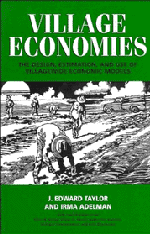Book contents
- Frontmatter
- Contents
- Acknowledgments
- 1 Introduction
- 2 Modeling village economies
- 3 The village economy and tenure security in West Africa: A Senegalese village SAM
- 4 Production and distribution in a dry-land village economy
- 5 Migration and the changing structure of a Mexican village economy
- 6 Economic linkages in a small regional economy: The case of Kutus Region, Kenya
- 7 Household nutrition and economic linkages: A village social accounting matrix for West Java, Indonesia
- 8 The village CGE: Basic model and estimation
- 9 Policy simulations
- 10 Conclusions
- Bibliography
- Index
2 - Modeling village economies
Published online by Cambridge University Press: 05 June 2012
- Frontmatter
- Contents
- Acknowledgments
- 1 Introduction
- 2 Modeling village economies
- 3 The village economy and tenure security in West Africa: A Senegalese village SAM
- 4 Production and distribution in a dry-land village economy
- 5 Migration and the changing structure of a Mexican village economy
- 6 Economic linkages in a small regional economy: The case of Kutus Region, Kenya
- 7 Household nutrition and economic linkages: A village social accounting matrix for West Java, Indonesia
- 8 The village CGE: Basic model and estimation
- 9 Policy simulations
- 10 Conclusions
- Bibliography
- Index
Summary
Villages in less developed countries often are very complex in their social, cultural, and political structures, yet the structure of their economic activities can be reasonably simple. Agricultural production forms the core of economic activity for the villages in this book. Some of this production is consumed by the production units themselves, and thus does not enter the exchange economy inside or outside the village. Many of the inputs used in production are supplied by the same production units, in the form of family factors (labor, draft animal power) or intermediate inputs produced by the household (e.g., saved seeds). Nevertheless, as Chapters 3 through 7 illustrate, economic activity varies strikingly among villages, often in ways that reflect villages' integration with outside markets.
Village economic linkages and market development
If all agricultural households were self-sufficient and supplied their own inputs – that is, if all goods were household nontradables – production and expenditure linkages among village households would be nonexistent. At the other extreme, if all households were perfectly integrated with goods and factor markets outside the village and all goods and factors were village tradables (i.e., in a perfectly neoclassical world), production and expenditure linkages among village households would again be nonexistent. All input and output prices would be exogenous, fixed by markets outside the village. An increase in a village household's demand for goods produced in the village would simply decrease the availability of these goods for sale outside the village (i.e., village-marketed surplus).
- Type
- Chapter
- Information
- Village EconomiesThe Design, Estimation, and Use of Villagewide Economic Models, pp. 9 - 30Publisher: Cambridge University PressPrint publication year: 1996



